#St. Stephen of Hungary
Explore tagged Tumblr posts
Text
On the 30th of May is the Feast Day of the Transfer of the Relics of King Saint Stephen of Hungary
The Holy Right Hand is a Hungarian national and catholic relic, said to be the naturally mummified right hand of Stephen I, first king of Hungary, also called Saint Stephen.
Saint Stephen (in Hungarian Szent István) was born around 970-975 in Esztergom. He was a member of the Árpád dynasty, born a pagan but baptized a Christian. In 996, he married Gisela of Bavaria, sister of the future Holy Roman Emperor Henry II. After the death of his father, the Grand Prince Géza, Stephen fought an insurrection led by his cousin, Koppány, who claimed the throne in accordance with the rules of succession of Árpád. After defeating Koppány, Stephen was crowned as (first) King of Hungary with a crown received from Pope Sylvester II.
His coronation, which took place around 1021 years ago on Christmas Day in the year 1000, marked Hungary's entry into the family of European Christian nations. Stephen made the Church the main pillar of his authority, sending missionaries throughout his kingdom, founding bishoprics and abbeys, and mandating the building of churches. He died in 1038 and became the patron saint of Hungary.
The king's right hand, naturally mummified, is one of the most importantrelics Hungarian nationals, discovered during the opening of his stone tomb on August 20, 1083 in Székesfehérvár. (The identifying mark of the right hand was the king's ring, which adorned the hand). Therelic had a few adventures in his time. During the Turkish occupation, it ended up in Ragusa (today: Dubrovnik, Croatia), where it was guarded by Dominican friars, attracting increasing numbers of pilgrims to the city.

Source of picture: https://relics.es
Queen Maria Theresa (1717-1780), late successor to Saint Stephen on the Hungarian throne, negotiated the return of the Holy Right Hand in 1771, offering in return the historic city of Ragusa its protection against the threat of Russian invasion. In her charter decree, she specified how the relic, the mummified hand of Saint Stephen, was to be respected throughout the country.
During World War II, the Holy Right Hand was concealed - along with the Coronation Jewels - near Salzburg, Austria. The relic returned to Hungary in 1945, and it has been on display in St. Stephen's Basilica in Budapest since 1987.
Source: https://relics.es/en/blogs/relics/la-sainte-main-droite-detienne-ier-roi-de-hongrie
#saints#relics#St. Stephen of Hungary#Transfer of the Relics of King Saint Stephen of Hungary#Holy Right Hand#God#Jesus#Christ#Jesus Christ#Father#Son#Holy Spirit#Holy Trinity#christian religion#faith#hope#love#stress reliever
8 notes
·
View notes
Text
"Sarolt of Transylvania is depicted in the written chronicles as a fierce, independent woman. The daughter of Gyula, Prince of Transylvania, she married Géza (r. 975–997), Prince of the Hungarians and the pair had one son, St. Stephen I of Hungary (r. 997–1038) and four daughters. Originally baptized in the Byzantine faith, Sarolt is lambasted by two Catholic chronicles; Thietmar of Merseburg states that she rode her horse like a soldier, was a dypsomaniac, and that she even murdered a man in a fit of rage. Bruno of Querfurt writes that she “had been holding the whole country in her power with a hand of a man, and who had been governing everything owned by her husband.” This depiction of Sarolt is in direct contrast with the fictitious Adelaide of Poland, a princess created by Polish chroniclers as a pious foil who marries Géza and converts him to Christianity. In 997, Prince Géza died and was interred at the chapel of SS Peter and Paul in Székesfehérvár. While Stephen succeeded his father as prince, a rival named Koppány, the duke of Somogy, claimed his right to the throne as a senior member and took steps to besiege Sarolt’s residence in Veszprém with the intention to marry her; Koppány was defeated by Stephen soon after. Sarolt is mentioned again in 1003 when Stephen defeated her brother, Gyula of Transylvania. After Gyula surrendered to Stephen, the prince was given a residence in the county of Heves, where his sister lived. While little is known of her outside of these events, there are two pieces of archaeological evidence that shed more light on her character: the room of the queen in the royal palace of Esztergom and the Greek nunnery at Veszprémvölgy. [...] The buildings and imagery associated with her appear to be traditional and religious in nature—the palace quarters are directly adjacent to the chapel in Esztergom and the Greek nunnery at Veszprémvölgy was possibly founded by her, her son St. Stephen or another close female relative. In this case, the woman associated with these archaeological sites shows no resemblance to the violent harridan in the Catholic chronicles written by German monks. While the particulars of Sarolt's exact relationship with these sites may never be known, they still nonetheless provide an alternate glimpse of a woman who has been severely maligned in the written record."
— Christopher Mielke, The Archaeology and Material Culture of Queenship in Medieval Hungary, 1000–1395 (Queenship and Power)
#Sarolt of Transylvania#hungarian history#historicwomendaily#10th century#11th century#Géza Grand Prince of the Hungarians#my post#St. Stephen I of Hungary#queue
25 notes
·
View notes
Text

St. Stephen's Procession in Budapest, Hungary
Hungarian vintage postcard
#postcard#budapest#ansichtskarte#briefkaart#hungarian#photography#st. stephen's procession#carte postale#vintage#postkarte#photo#historic#postkaart#ephemera#sepia#procession#stephen#tarjeta#postal#hungary
10 notes
·
View notes
Text

St. Stephen, King of Hungary.
#st stephen#king of hungary#kingdom of hungary#saints#catholicism#königreich ungarn#a.i.#magyar királyság#artificial intelligence#magyar király#a.i. art#árpád dynasty#árpád dinasztia#bearded men#szent istván király#saint stephen i
12 notes
·
View notes
Text
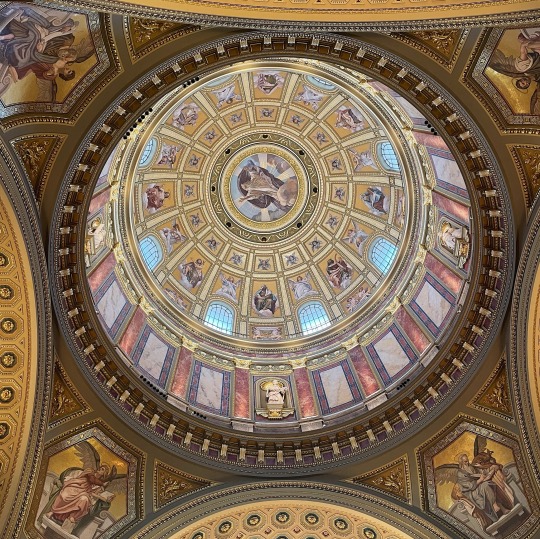
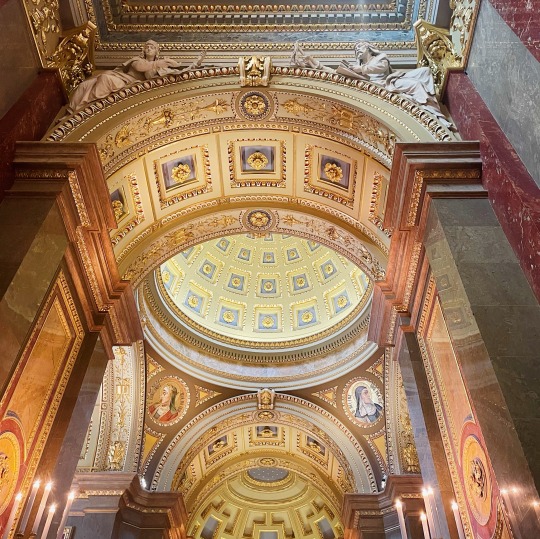


(don’t repost photos)
St. Stephen’s Basilica, Budapest, Hungary
#CO Photography#CO Posts#architecture#budapest#hungary#basilica#st stephens basilica#church#european architecture
19 notes
·
View notes
Text
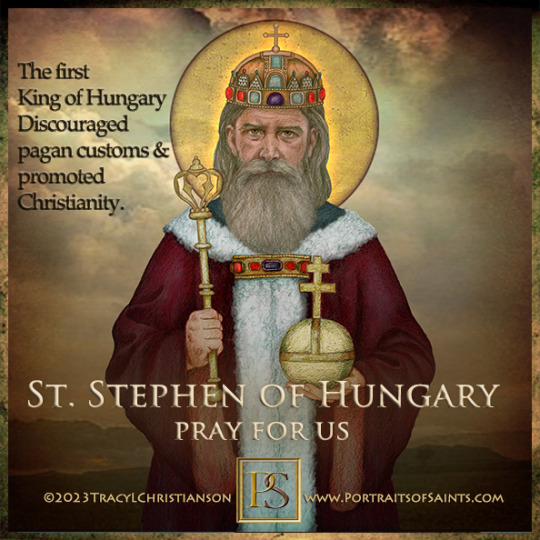
Saint Stephen King of Hungary
975 - August 15, 1038
Feast Day: August 16
Patronage: Hungary, kings, masons, stonecutters, stonemasons and bricklayers
Saint Stephen I, a devout Christian king, was baptized at ten with his father, the Magyar chieftain Geza. Stephen married Gisela, daughter of Duke Henry of Bavaria and then succeeded his father as leader in 997 and devoted most of his reign to the devotion of the Christian faith. In 1000 Stephen was anointed the first king of Hungary. He established Churches, a monastery in Jerusalem for pilgrims, a system of tithes to support the Church and the poor, and abolished pagan customs. He died on August 15 after an assassination attempt and many illnesses. He was buried alongside his son St. Emeric, and the two were canonized together in 1083.
Prints, plaques & holy cards available for purchase here: (website)
73 notes
·
View notes
Text




St. Stephen's Basilica, Budapest, Hungary
Bernard Hermant
10 notes
·
View notes
Text
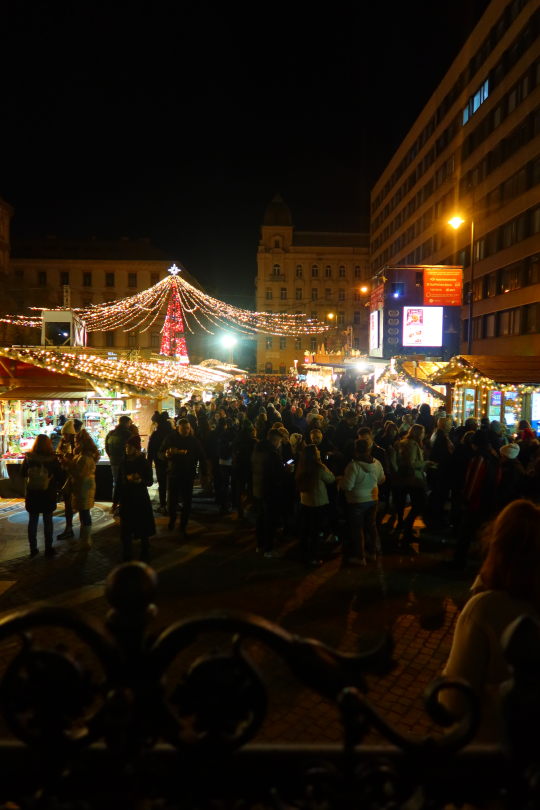

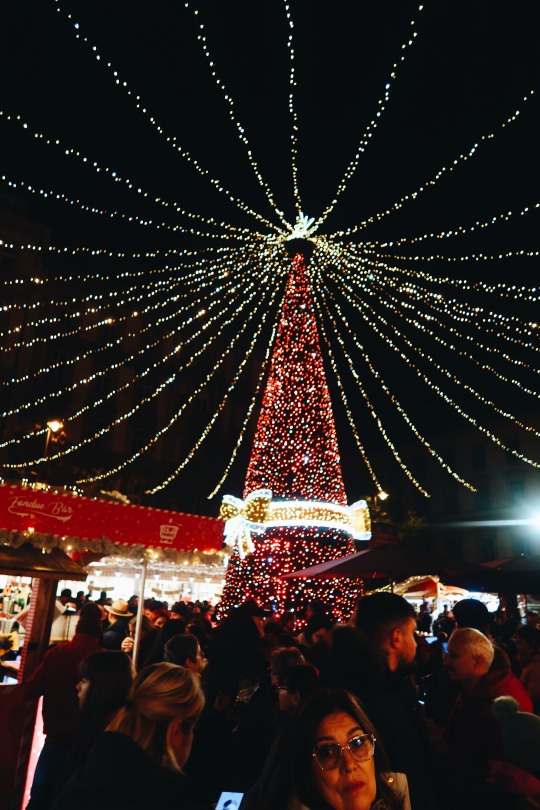
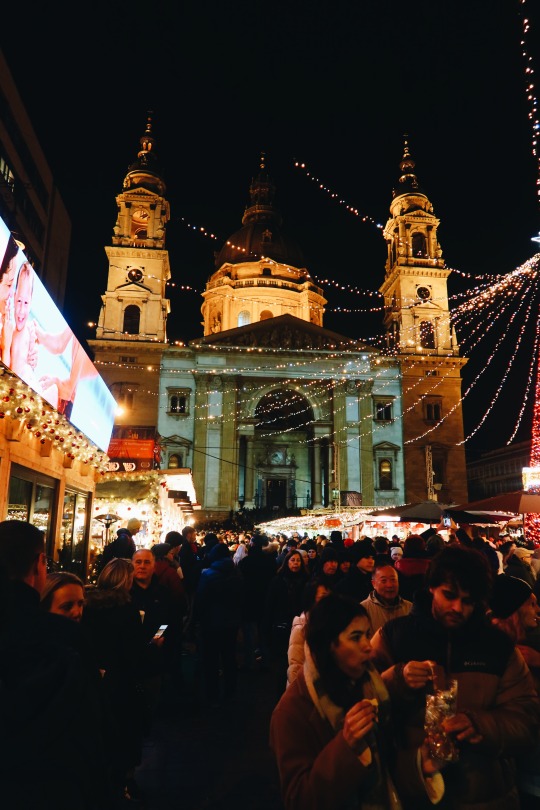

St. Stephen's Basilica
Christmas market
#St. Stephen's Basilica#christmas market#christmas#photography#budapest#hungary#travel#digital photography#tourism#travel blog#traveling#sightseeing#travel photography
2 notes
·
View notes
Text
SAINT OF THE DAY (August 16)

On August 16, the Catholic Church celebrates the feast day of King Saint Stephen of Hungary, the monarch who led his country to embrace the Christian faith during the 11th century.
Before the future saint's birth in 975, his mother, the Duchess Sarolt, is said to have received a vision in which the original Saint Stephen – the Church's first martyr – appeared telling her she would bear a son who would evangelize their land.
Together with her husband, the Hungarian Duke Geza, Sarolt is believed to have been converted and baptized by the bishop Saint Adalbert of Prague.
The same saint baptized their son Vaik in 985, giving him the name of Stephen.
Geza had desired to convert the Hungarians to the Catholic faith, a passion shared by Stephen once he reached adulthood and succeeded him in power.
After conclusively defeating an alliance of rival pagan nobility, he used their acquired wealth to build a monastery and invited clergy to convert the people.
Stephen established laws favoring Christianity over paganism and sent an emissary to Rome with a request for the Pope to proclaim him as king.
Pope Sylvester II accepted the request, sending him a crown and a gold processional cross, while also giving Stephen certain religious privileges.
He showed great diligence as king, while devoting the rest of his time to his religious duties – including charity toward the poor and sick, as well as the worship of God – and to his household.
Gisela, Stephen's wife, was the sister of the ruler later canonized as the Holy Roman Emperor Saint Henry II.
Greatly devoted to the Virgin Mary, Stephen had several churches built in her honor both in Hungary and outside the kingdom.
Her intercession is credited with preventing a war between Hungary and the Holy Roman Empire under Conrad II, and stopping an assassination plot against Stephen himself.
The Hungarian king also established a monastery in Jerusalem and set up institutions to aid pilgrims in other major cities.
Stephen counted saints among his friends and correspondents, and fulfilled the Pope's charge to use his royal authority for the good of the Church.
Suffering came to the king, however, when only one of his children survived to adulthood.
Stephen's only living son Emeric received a strong Catholic upbringing and was expected to succeed his father.
But Emeric died before Stephen after a hunting accident in 1031.
Emeric was later canonized as a saint in his own right, and Stephen eventually came to rejoice that his son had been permitted to enter God's presence before him.
The king's final years, however, were marked by illness as well as a succession dispute among his relatives.
In 1038, on the feast of the Assumption of the Virgin Mary, Stephen delivered his final words to leaders of the Church and state, telling them to protect and spread the Catholic faith.
To the Virgin Mary, the king directed one of his final prayers:
“To thee, O Queen of heaven, and to thy guardianship, I commend the holy Church, all the bishops and the clergy, the whole kingdom, its rulers and inhabitants; but before all, I commend my soul to thy care.”
Stephen of Hungary died on 15 August 1038.
He was buried alongside his son St. Emeric, and the two were canonized together in 1083.
3 notes
·
View notes
Text
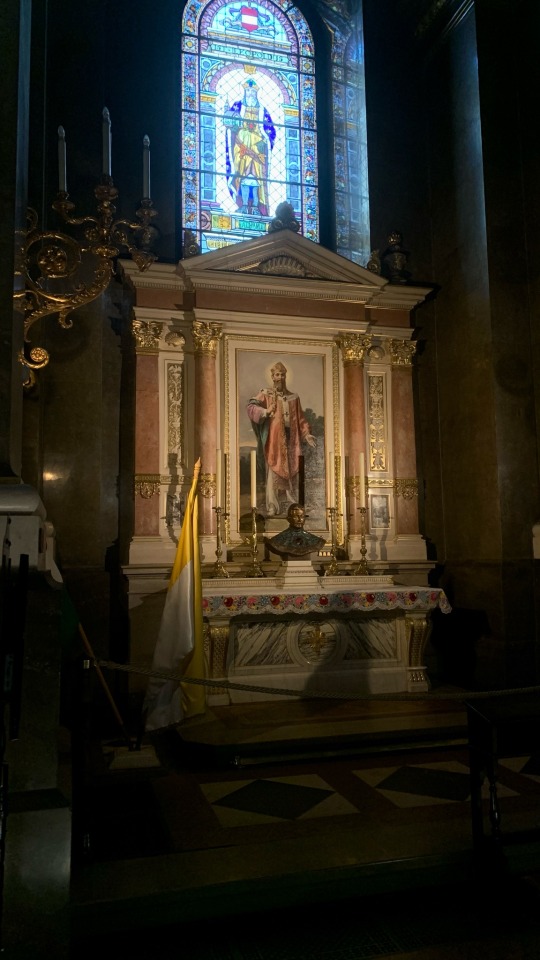

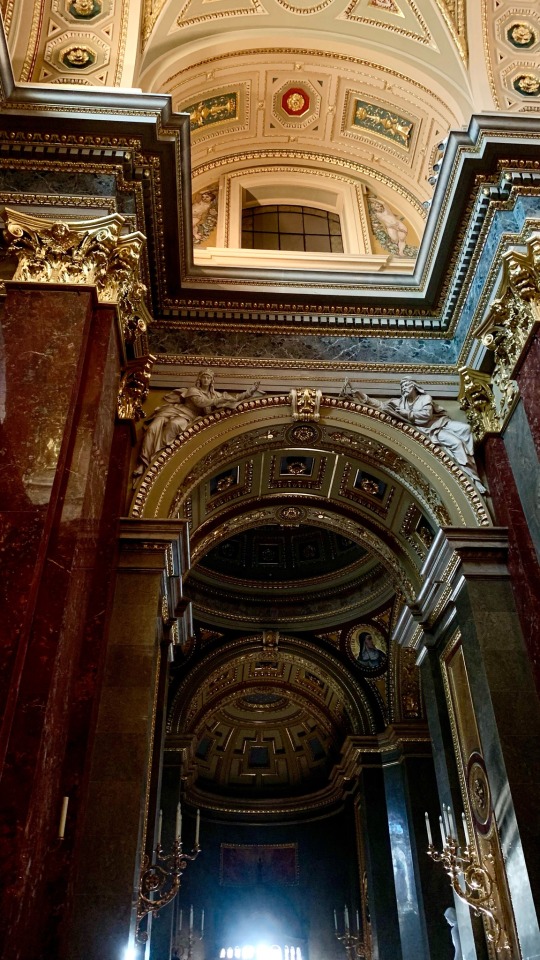
More of the same
5 notes
·
View notes
Text
Budapest
We arrived in Budapest by bus instead of our ship, and we had to get up and out extra early to do it. The main entry on the ship was full of luggage tagged for people going to the airport, to the official hotel in Budapest, or to a drop-off for those going their own way. As usual, three ships were at the dock; ours was the furthest. The main entries for the ships usually don't line up well, so we passengers had to go up to the top deck and cross from ship to ship there, then down to the entry of the last ship and up the ramp to shore. In the meantime, the staff was doing a bucket brigade with the luggage between ships, lifting them over all the railings. Then we had to wait at our bus for our luggage to arrive and identify it before loading it. It all happened in what looked a bit like chaos but on time and amazing efficiently, no thanks to the passengers.
Our drop-off in Budapest was only a few blocks from our apartment and we had arranged an early arrival there, so we could walk directly there and let ourselves in. In line with our individual inclinations, Cathie wanted a nap after that morning, and I wanted a walk. The main market was about a mile away, PERFECT!
There was a pedestrian street that covered most of the distance. Budapest has many miles of beautiful pedestrian streets with stone paving blocks lined with shops, cafes, and restaurants. So it's a lovely walking city. The cafes, bars and restaurants were all busy and a lot of people on the street.


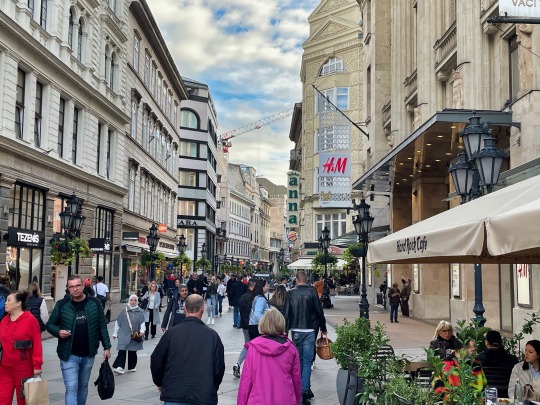
The whole pedestrian street and many more is paved with stone tiles. They were paving the side streets around it.
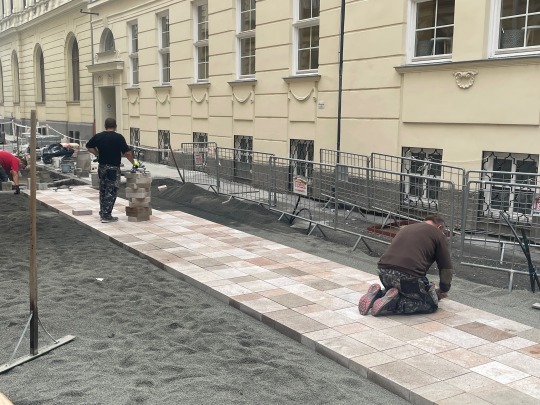
It takes a lot of labor compared to concrete, but looks so much better!
The manhole covers in these areas are also beautiful with a bronze finish.

There are also monuments and statues all through the city.
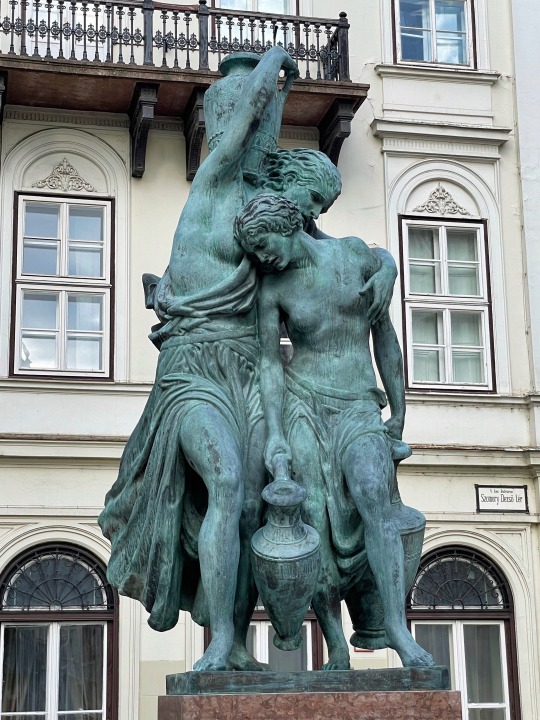
The whole effect is a very inviting atmosphere.
I think a big difference between Europe and the US is people here expect to walk, and enjoy walking. Most Americans want to drive to a store and then drive to the next store. Even the big shopping malls are dying, because people don't want to walk. I love to walk so it is a real pleasure to be somewhere that is designed for walkers!
We were learning more modern local history and much of Budapest was run down and in bad shape until the early 1990's. If so, they have made an amazing transformation in 30 years.
The market building is impressive.
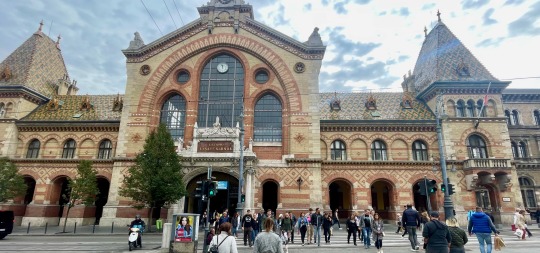
Inside many of the stalls are selling tourist goods, of course, but there are still plenty of places selling fruits and vegetables.


I bought an onion and a pepper, eggs, and some mushrooms thinking of omelets for breakfast. I also got some fruit and bread and spotted a vendor selling dried and candied fruit. I've been thinking that it's been a while since we made fruitcake, in part because the fruit has gotten harder to find. So I went back the next day and bought a load.
The buildings from the late 1800's to early 1900's are the stars of the urban landscape here. But many of the modern buildings are also handsome.


A big question in my mind has been how to get around, since Cathie can't walk as far as she used to. We discussed local transit and the Hop-On/Hop-Off buses. I took a trip across town using the local transit app. I was fairly confused. I knew I needed to start at one transit station and the number of the subway line, or was it the bus, or maybe the tram? There is a small icon of a vehicle, but on my phone, I could not tell them apart. I assumed that it was the subway. It looked like the color of one of the subway lines. But I couldn't find one that had the destination station. So I went back up top and found that it was also the end station for some of the tram lines and one tram line matched up. After that, it worked fine. I'm still not sure if the online ticket I bought and validated at the subway station was valid for the tram. Another problem with transit is while the subway may be efficient, you do not see the city at all!
I decided that all might be confusing for Cathie and got tickets for the HO/HO buses. The first one we took was terrible: the motor was so loud we couldn't hear a thing and the inside of the bus smelled of diesel fumes. The woman making the announcement is incomprehensible to us. The stairs to the top were closed. When we got on, and only later figured out that there was another one in the back.
When we got off and then caught a later bus it was much newer, quieter, and didn't stink, also the announcer was much better.
The other trouble with the HO/HO buses is they run in a loop, in one direction only. So to go to a place and back would mean doing the whole loop again.
My conclusion was that the thing to do is to spend more time figuring out the public transit options and operations. If the trams or buses work for your destinations it's the best option. The HO/HO buses are only for those who do not want to do that.
We didn't do much in the way of churches and museums. Cathie didn't have the energy and I didn't have enough interest. But St. Stephen's Basilica was just a couple of blocks away, so we went.

The pavement in front was incredible. It was mosaic like that in Roman churches, but outside!

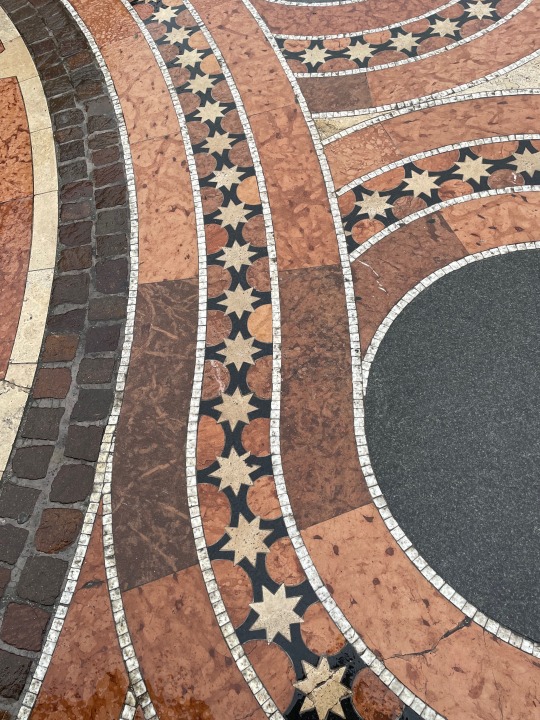
Like much of Budapest, it was built between 1850 and 1905. So it's not ancient. But 150 years of Ottoman rule will really constrict your church building.
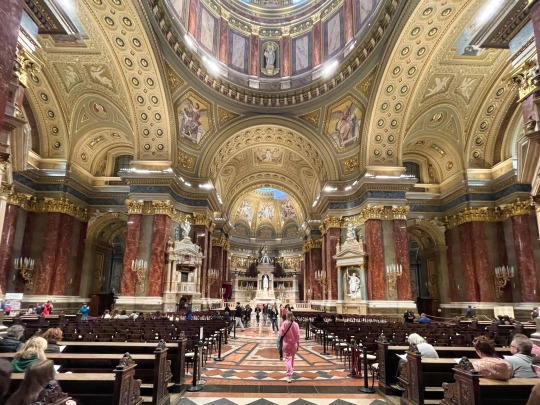



We went on the roof and had a great view across the city.
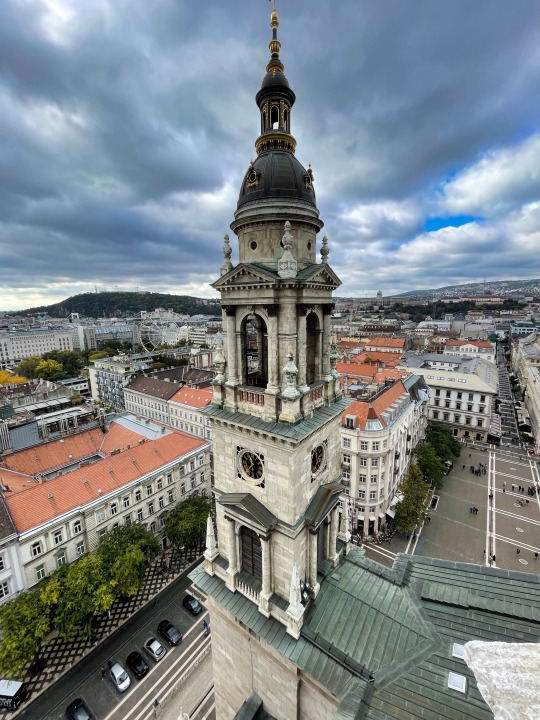
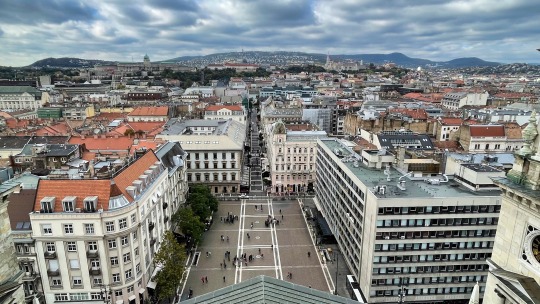
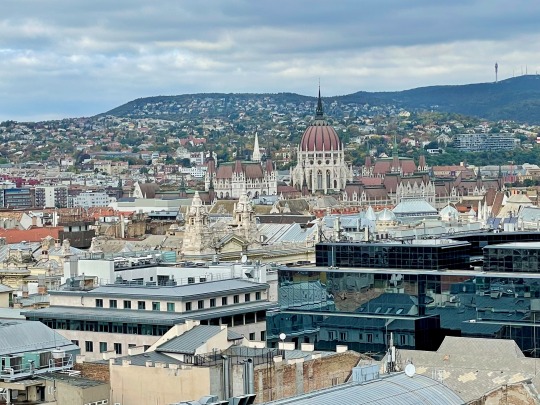
2 notes
·
View notes
Text
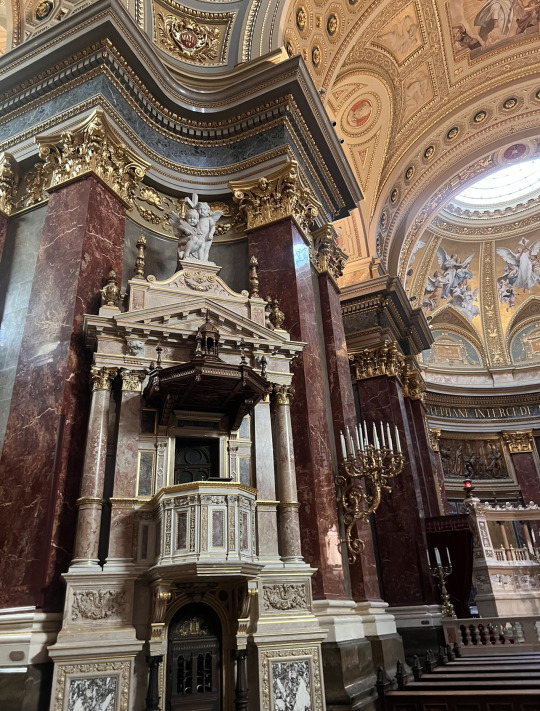
3 notes
·
View notes
Text

3 notes
·
View notes
Text

St. Stephen King of Hungary.
#saints#catholicism#christianism#maguar királiság#königreich ungarn#st stephen#king of hungary#árpád dynasty#bearded men#szent istván király#árpád dinasztia#magyar király
6 notes
·
View notes
Text

Statue of St. Stephen I, Fisherman's Bastion, Budapest, Hungary
Linda Gerbec
#Statue of St. Stephen I#Fisherman's Bastion#Budapest#Hungary#Statue#Europe#HungaryArt#Sculpture#St. Stephen I
3 notes
·
View notes
Text

Christmas Market, St. Stephen's Basilica
Less crowded in the day, easier to get some food.
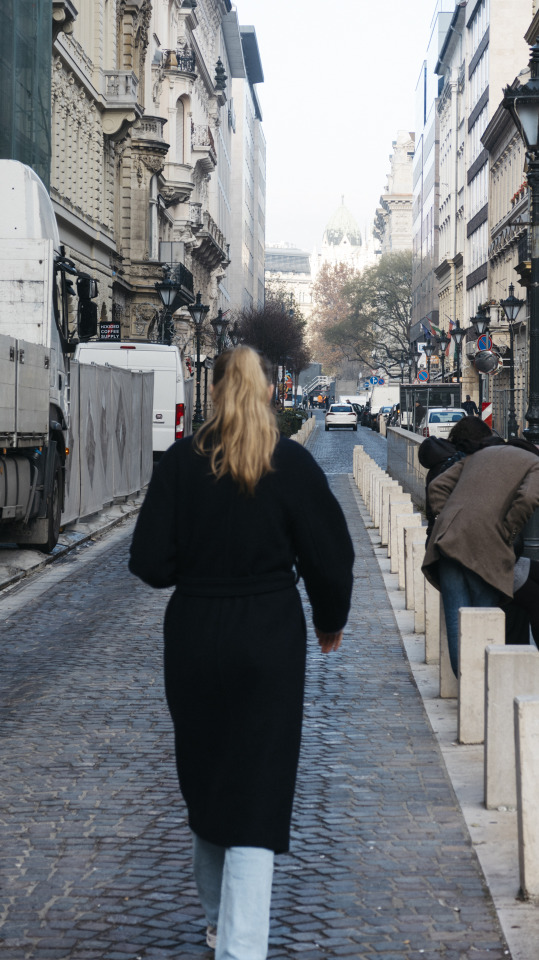


1 note
·
View note